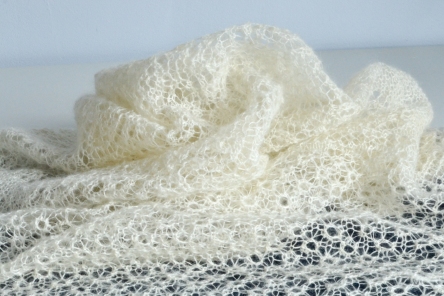spinning.…………..preparing fleece ……… spindles and electric spinner..……fine spinning…….. fancy spinning
‘Wool’ is an umbrella term covering such a wide ranging fibre that one could just spin wool and never tire of it. A couple of examples will illustrate some very different variations.
I can ‘feel’ the softness of the soft short fibres of the undercoat of the North Ronaldsay yarn on the left! the harsh outer fibres were removed, as much as I could. The yarn was then acid dyed and knitted to a vintage design for an exhibition, to celebrate 100 years of the use of the term brasserie a few years ago.



From the short fibres of the undercoat of North Ronaldsay fleece to the long fibres of Lincoln Longwool. These are shown as 15″ long here, but when combed out will be longer. They can be spun finely and records suggest the spun fibre was used in the textile industry in Norwich. As you can tell they are wonderfully lustrous.
unwashed on the left, washed on the right.
On the Fine Spinning page there is a skein of some Lincoln Longwool and I also show some of the other fleece types and other fibres which I have spun finely.
One of the ‘other than wool’ animal fibres I enjoy spinning is silk. This is another fibre that was important in the textile heritage of Norfolk, particularly during the period of the heyday of the Norfolk Shawls. This silk would have most likely been spun on a drop spindle and the thinness achieved in this is eye watering, even by today’s fine spinning standards.

I am also drawn historically to the links with linen, another very important fibre in Norfolk’s textile past. I was fortunate to be taught ‘linen spinning’ by Riitta Sinkonen Davis many years ago.1 This involved using a home made distaff (a machine knitting yarn inner cone on a broom handle lashed to the spinning wheel).
Some examples of spinning of animal fibres other than sheep! Each fibre was spun to the same thickness (in terms of wpi)

From the left: alpaca, angora, camel, cashmere, goat, mohair, possum, yak (there is more about alpaca here)
Some examples of plant fibres, again spun to the same thickness (wpi)

From the left: bamboo, cotton, linen, ramie, soya, tencel, viscose
The following example is from a few years ago. I designed the bag for an exhibition at Little Moreton Hall which is a fine building which shouts Tudor at you. I took as inspiration a dress of Elizabeth I but spun the lace weight yarn from recycled plastic bottles. It is a 2 ply yarn. I really like the idea that waste plastic bottles can be made into lace like this. The lining and handle are of silk which I have dyed blue with an acid dye (see synthetic dyeing page). Could you have guessed the origin of the yarn?

Notes
- Riitta’s blog is at http://www.riittaweaving.wordpress.com and shows some of her beautiful weaving too.
©Janet Major All rights reserved
